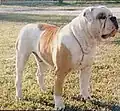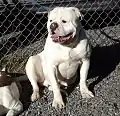American Bulldog
The American Bulldog is a large, muscular breed of mastiff-type that was used as stock dogs, catch dogs, and guardians on farms and ranches.[2] The breed is descended from the Old English Bulldog, which is thought to have arrived in America as early as the 17th century, brought over by working-class immigrants from England.[3][4] During WWI and WWII, the breed was on the verge of extinction, with the only surviving dogs being kept primarily on farms in the southeast. John D. Johnson and Alan Scott are widely regarded as the forefathers of rescuing the breed from extinction. [2] On January 1, 1999, the United Kennel Club first recognized the American Bulldog.[4] In November 2019, the American Bulldog was added to the American Kennel Club (AKC) Foundation Stock Service (FSS).[5]
| American Bulldog | |||||||||||||||||||||||||||||||||
|---|---|---|---|---|---|---|---|---|---|---|---|---|---|---|---|---|---|---|---|---|---|---|---|---|---|---|---|---|---|---|---|---|---|
 American Bulldog | |||||||||||||||||||||||||||||||||
| Other names | Southern White White English Old Southern White Bulldog Hill Bulldog Country Bulldog English White Bulldog | ||||||||||||||||||||||||||||||||
| Origin | United States | ||||||||||||||||||||||||||||||||
| |||||||||||||||||||||||||||||||||
| |||||||||||||||||||||||||||||||||
| Dog (domestic dog) | |||||||||||||||||||||||||||||||||
History
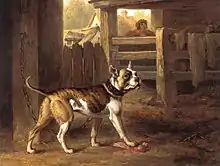
The Old English Bulldog was preserved by working-class immigrants who brought their working dogs with them to the American South; these dogs are believed to have first appeared as early as the 17th century. Small farmer and ranch owners used this all-around working dog for many tasks including farm guardians, stock dogs, and catch dogs. These dogs were not a bona fide breed by modern standards as was the case for most other dogs; kennel clubs and breed registries did not exist until 1875,[6] at least two centuries after the Old English Bulldog first migrated to America. In the 17th and 18th centuries, the Old English Bulldog had many different strains for cattle-droving, bull-baiting, farm dogs, and butcher's dogs.[7][8][9] Bull-baiting was also a common blood sport of the era and though evidence exists of such migrating to America with the landrace bulldogs brought by working-class Englishmen in colonial times, the strains that migrated to America certainly were unaffected by the banning of the sport in 1835 in the U.K., so no need was seen for a decline in the population of the old-type bulldog.
In America, no records remain, but rather landrace strains are acknowledged that initially depended on where a dog's master originated in England, the majority of which were bred to work as evidenced by accounts of the age in local newspapers and written inventories upon death. Later, breeding decisions were dependent on the best working farm dogs, despite breed or background. Later, in states such as Texas, several separate strains of the "bulldog"-type dogs were kept by ranchers as utilitarian working dogs. Other dogs in time became guard dogs on plantations.[10]
Perhaps the most important role of the American Bulldog and the reason for its survival, and in fact why it thrived throughout the South, was because of the presence of feral pigs, introduced to the New World and without predators. The bulldogs were the settlers' only means of sufficiently dealing with the vermin.
By World War II, the breed was near extinction until John D. Johnson scoured the backroads of the South looking for the best specimens to revive the breed. During this time, a young Alan Scott grew an interest in Johnson's dogs and began to work with him on the revitalization process.[11][12][13] At some point, Scott began infusing non-Johnson catch bulldogs from working Southern farms with Johnson's lines, creating what is now known as the Standard type American Bulldog, also called the Scott type. At another point, Johnson began crossing his original lines with an atavistic English Bulldog from the North that had maintained its genetic athletic vigor, creating the Bully type American Bulldog, also known as the Johnson type or the Classic type.
American Bulldogs are now safe from extinction and their popularity has increased in their homeland, either as a working/protector dog, as a family pet, or both. All over the world, they are used variously as "hog dogs" (catching escaped hogs or hunting feral pigs), as cattle drovers, and as working or sport K-9s. American Bulldogs also successfully compete in several dog sports such as dog obedience, Schutzhund, French Ring, Mondioring, Iron Dog competition, and weight pulling. They are also exhibited in conformation shows in the UKC, ABA, ABRA, ORKC, EKC, and NKC. The AKC added the American Bulldog to the FSS on November 11, 2019.[14]
Appearance
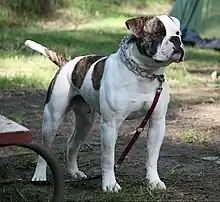
The American Bulldog is a stocky, well-built, strong-looking dog, with a large head and a muscular build. The shoulders and chest tend to be the most muscular parts of the American Bulldog. Its coat is short and generally smooth, requiring little maintenance except a bath every few weeks. The breed is a light to moderate shedder. Colors, while historically predominantly white with patches of red, black, or brindle, have grown in recent years to include many color patterns, including black, red, brown, fawn, and all shades of brindle. Black pigmentation on the nose and eye rims is traditionally preferred, with only some pink allowed. Eye color is usually brown, but heterochromia also occurs, although this is also considered a cosmetic fault. American Bulldogs are known to drool more than other breeds of dogs. The Bully type is generally a larger, heavier dog with a shorter muzzle, but the muzzle should never be so short that it causes difficulty with breathing. Standard types are generally more athletic with longer muzzles and a more square head. Many modern American Bulldogs are a combination of the two types, usually termed "hybrid". In general, American Bulldogs weigh between 27 and 54 kg (60 to 120 lb) and are 52 to 70 cm (20 to 28 in) at the withers, but have been known to greatly exceed these dimensions, especially in the "out of standard" nonworking stock.
Temperament and characteristics
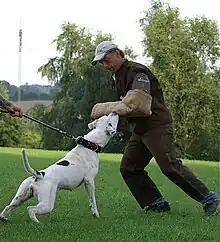
American Bulldogs are typically considered to be confident, and are social dogs, up ease with families.[15] They bond mostly with their owners. They are not as friendly with people they do not know; since their ancestors were farm dogs that guarded the home, the livestock, and the children when their master was away.[16] They mature later than many other breeds, not until the age of two, and as puppies they will be curious yet aloof with strangers, but confident at maturity.[17]
Unlike most other bulldog breeds, they are competent swimmers. Though they do not have the affinity for water a retriever would: they swim if they have to, not because they particularly enjoy it.[18]
They also double as a boarhound, and in its homeland it is often both a pet and a hunter at the same time: Southern Americans prize this breed as a 'courageous canine warrior'. However, they also prize the breed as having a soft, affectionate inner nature.[19][20] As a working breed, they are good on pigs as catch dogs and decent on cattle: they are capable of resisting a steer while retaining the herding instinct.[21][22] The American Bulldog is an affectionate breed of dogs known for protecting their owner.[23][24]
Health

American Bulldogs generally live from 10 to 16 years, and tend to be strong, physically active, and often healthy. Some health problems in American bulldogs are often found within certain genetic lines, and are not common to the entire breed, while others, such as neuronal ceroid lipofuscinosis (NCL),[25] Ichthyosis, disorders of the kidney and thyroid, ACL tears, hip dysplasia, cherry eye, elbow dysplasia, entropion, ectropion, and bone cancer are more common to the general population of American Bulldogs. There are DNA tests available to help breeders screen breeding animals for NCL (neuronal ceroid lipofuscinosis)[25] and Ichthyosis. A Penn Hip (Pennsylvania Hip Improvement project) or OFA (Orthopedic Foundation for Animals) screening is recommended for all potential breeding animals. Some American Bulldogs are prone to allergies. Due to the ideal of beauty regarding the shape of the face the skull malformation brachycephaly was increased by breeding selection.
In popular culture
- Spike and Tyke from the Tom and Jerry franchise
- Muggshot, a boss character from the Sly Cooper series and enforcer of the Fiendish Five
- The Deftones' video Bloody Cape featured a model walking an American Bulldog down the street. The American Bulldog was actually played by two separate dogs from the Norcal's American Bulldog Kennel. The names of the dogs were Big Trouble and Tory Hesta.
- In Return to Me (2000), David Duchovny's character's dog, Mel, is played by an American Bulldog named Peetey.
- In the 2001 film Kevin of the North, one of Kevin Manley's sled dogs is an American Bulldog named Snowflake.
- Nedd ("Nasty Evil Dead Dog") in The Number 23 (2007)
- In Tucker & Dale vs. Evil (2010), Jangers, Tyler Labine's character's dog, is played by an American Bulldog named Weezer.
- An American Bulldog features prominently as the titular character's companion in the 2013 film Joe.
- The company logo for Zynga also featured an American Bulldog and was named after Mark Pincus' dog "Zinga".
- Since the 1990s, American Bulldogs have become more frequently used in films as family pets, replacing the previously popular American Pit Bull Terriers and Bull Terriers.[26] For example:
- Chance from the feature film Homeward Bound: The Incredible Journey (1993) and its sequel, Homeward Bound II: Lost in San Francisco (1996). Suregrips Rattler (Chance) was only in the first Homeward Bound movie. The first film based on The Incredible Journey featured a Bull Terrier.
- Although the original Petey from Hal Roach's Our Gang was an American Pit Bull Terrier, in the 1994 film remake The Little Rascals, Petey was played by an American Bulldog.
- In Cheaper by the Dozen (2003) and Cheaper by the Dozen 2 (2005), an American Bulldog named Gunner is the family pet.
Gallery
See also
References
- Maggitti, Phil (October 1, 2018). Bulldogs. Barron's Educational Series. ISBN 9780764196539. Retrieved October 1, 2018 – via Google Books.
- "DECLARATION of FACTS" (PDF). Dogsbite.org. Retrieved September 29, 2018.
- "American Bulldog Dog Breed Information". American Kennel Club. January 13, 2020. Retrieved April 21, 2022.
- "Breed Standards : American Bulldog". United Kennel Club (UKC). January 1, 1999. Retrieved April 20, 2022.
- "FSS News & Updates – American Kennel Club". American Kennel Club. November 11, 2019. Retrieved November 15, 2019.
- "History of the Kennel Club". www.thekennelclub.org.uk.
- Merret, Christopher (1666). Pinax Rerum Naturalium Britannicarum, continens Vegetabilia, Animalia, et Fossilia. p. 169.
- "Bulldog: Get The Low Down On This Breed | CanineJournal.com". June 1, 2016.
- "The History Of Bulldogs". June 28, 2019.
- "American Bulldog Dog Breed Information - Continental Kennel Club".
- DK (October 17, 2013). The Dog Encyclopedia: The Definitive Visual Guide. Dorling Kindersley Limited. ISBN 9781409350026 – via Google Books.
- Harris, David (July 24, 2012). The Bully Breeds. i5 Publishing. ISBN 9781621870326 – via Google Books.
- Manfield, Mark (February 1, 2017). American Bulldog Bible And the American Bulldog: Your Perfect American Bulldog Guide Covers American Bulldog Puppies, Mini Bulldogs, American Bulldog Training, Johnson Bulldog, And More!. DYM Worldwide Publishers. ISBN 9781911355458 – via Google Books.
- "FSS News & Updates – American Kennel Club". American Kennel Club. November 12, 2017. Retrieved November 15, 2019.
- Mehus-Roe, Kristin (October 4, 2011). Original Dog Bible: The Definitive Source for All Things Dog. i5 Publishing. ISBN 9781935484899. Retrieved October 1, 2018 – via Google Books.
- "American Bulldog Facts". American Bulldog Rescue.
- "When Does an American Bulldog Stop Growing? | Cuteness". Cuteness.com.
- "American Bulldogs Frequent Asked Questions About the Breed -".
- "Hog Dogs: The Best Breeds for Hog Hunting". Wide Open Spaces. October 22, 2018.
- McEldowney, Mykal. "Wild hogs put hunters to the test". The Greenville News.
- "The American Bulldog". www.woodyacresranch.com. Archived from the original on March 31, 2017. Retrieved March 3, 2020.
- "Bulldog herding cattle". YouTube. Archived from the original on December 21, 2021.
- "Heroic American Bulldog Saves His Family". September 13, 2012.
- "Heroic bulldog saves family's lives by keeping murderer at bay". April 17, 2015.
- "NCL description for American Bulldogs". Caninegeneticdiseases.net.
- "American Bulldog Movies – Reel Dogs". Reeldogs.com. April 20, 2015. Retrieved September 29, 2018.


